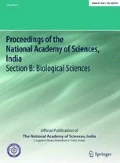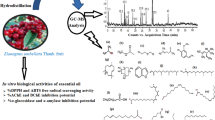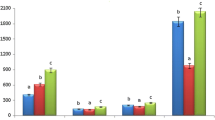Abstract
The study estimated bioactive compounds in various parts of Morinda citrifolia L. with special reference on fruits, leaves and seeds. Significant (p < 0.05) differences were observed in various parts for polyphenol, flavonoids, tannins, carotenoids, ascorbic acid, nitrate, oxalate and phytate contents. Determination of DPPH antioxidant activity of different parts revealed that aqueous extract scavenged significantly (p < 0.05) more DPPH free radicals than methanol and acetone extracts. Val-Tyr-Val and Meth-enkephalin polypeptides were high in leaves while Ly-Tyr and Leu-enkephalin in fruits. Fatty acid profiles of Morinda seeds revealed them as rich source of linolenic acid, stearic acid, oleic acid and lauric acid. Strong correlations were observed between antioxidant activity and carotenoids (R 2 = 0.774, p = 0.021). Information on bioactives and high free radical scavenging activity of M. citrifolia parts supports their various health claims.
Similar content being viewed by others
References
Singh DR, Singh S, Salim KM, Srivastava RC (2011) Estimation of phytochemicals and antioxidant activity of underutilized fruits of Andaman & Nicobar Islands (India). Int J Food Sci Nutr 63(4):46–52
Chan BY, Vaillant F, Perez AM, Reynes M, Brillouet JM, Brat P (2006) The Noni fruit (Morinda citrifolia L.): a review of agricultural research, nutritional and therapeutic properties. J Food Comp Anal 19:645–654
Korkina LG, Afanasev IB (1997) In: Sies H (ed) Antioxidants in disease mechanisms and therapy. Academic Press, San Diego, pp 151–163
Zin MZ, Abdul Hamid A, Osman A, Saari N (2006) Antioxidative activities of chromatographic fractions obtained from root, fruit and leaf of Mengkudu (Morinda citrifolia L.). Food Chem 94:169–178
Ma X, Wu C, Wang W, Li X (2008) Peptides from plants: a new source for antitumor drug research. Asian J Traditional Med 1:85–90
Simpoulos AP (1990) Essential fatty acids in health and chronic disease. Am J Clinic Nutr 70:560S–569S
Kim HK, Kwon MK, Kim JM, Kim CK, Lee YJ, Shin HJ, Lee J, Lee HS (2010) Identification of novel fatty acid glucosides from the tropical fruit Morinda citrifolia L. Phytochemistry 3:238–241
Raghuvanashi RS, Singh R, Singh R (2001) Nutritional composition of uncommon foods and their role in meeting micronutrient needs. Int J Food Sci Nutr 52:331–335
Johnson IT, Gee JM, Price K, Curl C, Fenwick GR (1986) Influence of saponins on gut permeability and active nutrient transport in vitro condition. J Nutr 116:2270–2277
Peter PI (2007) Monograph on Noni (Morinda citrifolia L.). World Noni Research Foundation, Chennai, pp 1–852
Singleton VL, Rossi JA (1965) Colorimetry of total phenolics with phosphomolybdic–phosphotungstic acid reagents. Am J Enol Vitic 16:144–158
Chang CC, Yang MH, Wen HM, Chern JC (2002) Estimation of total flavonoid content in propolis by two complementary colorimetric methods. J Food Drug Analysis 10:178–182
AOAC (1995) Association of official methods of analysis, 16th edn. American Public Health Association, Washington DC
Lichtenthaler HK, Buschmann C (2001) Chlorophylls and carotenoids: measurement and characterization by UV-VIS spectroscopy. In: Wrolstad RE (ed) Current protocols in food analytical chemistry. John Wiley, New York, F4.3.1–F4.3.8
Sadasivam S, Manikam A (1992) Hand book of biochemical methods. Wiley, Madras
Hassan LG, Dangoggo SM, Umar KJ, Saidu I, Folorunsho FA (2008) Proximate, minerals and antinutritional factors of Daniellia oliveri seed kernel. Chem Class J 5:31–36
Nadhala RA, Moyo M, Staden VJ (2010) Natural antioxidants: fascinating or mythical biomolecules. Molecules 15:6905–6930
Zin MZ, Abdul Hamid A, Osman A (2002) Antioxidant activity of extracts from Mengkudu (Morinda citrifolia L.) root, fruit and leaf. Food Chem 78:227–231
Singh S, Singh DR, Salim KM, Srivastava A, Singh LB, Srivastava RC (2011) Estimation of proximate composition, micronutrients and phytochemical compounds in traditional vegetables from Andaman & Nicobar Islands. Int J Food Sci Nutr 62(7):765–773
Deng S, West BJ, Jensen J (2010) A quantitative comparison of phytochemical components in global Noni fruits and their commercial products. Food Chem 122:267–270
Chung YL, Wang JS, Chen SY (2004) Comparison of antioxidative activity of crude extracts from leaves, stems and fruits of Morinda citrifolia (Noni). Master thesis, Chia-Nan University of Pharmacy and Science, Tainan, Taiwan 13
Erdmann K, Cheung BWY, Schroder H (2008) The possible roles of food-derived bioactive peptides in reducing the risk of cardiovascular disease. J Nutr Biochem 19(10):643–654
Borsook D, Hyman SE (1995) Proenkephalin gene regulation in the neuroendocrine hypothalamus: a model of gene regulation in the CNS. Am J Physiol Endocrinol Metab 269(3):E393–E408
Pino JA, Marquez E, Castro D (2009) Volatile and non-volatile acids of Noni (Morinda citrifolia L.) fruit. J Sci Food Agric 89(7):1247–1249
Author information
Authors and Affiliations
Corresponding author
Rights and permissions
About this article
Cite this article
Singh, D.R., Singh, S. Phytochemicals in Plant Parts of Noni (Morinda citrifolia L.) with Special Reference to Fatty Acid Profiles of Seeds. Proc. Natl. Acad. Sci., India, Sect. B Biol. Sci. 83, 471–478 (2013). https://doi.org/10.1007/s40011-013-0154-1
Received:
Revised:
Accepted:
Published:
Issue Date:
DOI: https://doi.org/10.1007/s40011-013-0154-1




